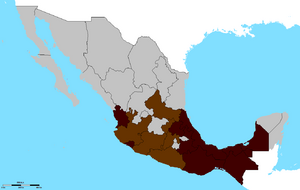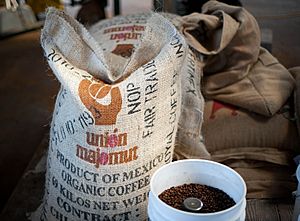Coffee production in Mexico facts for kids
The coffee production in Mexico is a big deal! Mexico is one of the top countries in the world for growing coffee. In 2009, they produced about 252,000 tonnes (that's 252,000,000 kilograms!) of coffee. Most of this coffee comes from the southern parts of the country.
The main type of coffee grown is called arabica. This coffee plant loves the warm, coastal area of Soconusco in Chiapas, which is close to Guatemala.
Coffee first arrived in Mexico from the Antilles islands in the late 1700s. But it wasn't until the 1870s that Mexico started exporting a lot of it. By the 1980s, coffee became Mexico's most important crop to sell to other countries. Today, Mexico sends more coffee to the United States than any other country. Some famous Mexican coffee beans include Altura, Liquidambar MS, and Pluma Coixtepec.

Contents
How Coffee Came to Mexico
Coffee was first brought to Veracruz, a state in Mexico, in the late 1700s. In 1954, coffee prices went up a lot around the world. This made Mexico a good place to grow coffee because it cost less there.
By the late 1800s, coffee growing spread to Chiapas. This area soon became the main place for coffee farms in Mexico. By the early 1980s, coffee farms were growing fast across 12 different states.
In 1982, almost 500,000 hectares of land in Mexico were used for coffee. That's a huge area! During the 1970s and 1980s, growing coffee was very important for Mexico's economy. It provided jobs and income for over two million people. Selling coffee to other countries also brought a lot of foreign money into Mexico.
The Mexican Coffee Institute (INMECAFE)
The Mexican Coffee Institute, or INMECAFE, was a government group. Its job was to help coffee farmers, manage how much coffee Mexico could export, and keep coffee prices steady.
Thanks to INMECAFE, more land was used for coffee. This helped coffee production grow quickly. Three main states—Chiapas, Veracruz, and Oaxaca—grew most of Mexico's coffee.
Between 1970 and 1982, the land used for coffee grew by over 140,000 hectares. Mexico's coffee production increased by about 6,000 tons of green coffee each year. INMECAFE also taught farmers how to use new farming methods and technologies to grow more coffee.
In 1989, INMECAFE was closed down. The Mexican government decided to stop controlling the coffee market. This change meant farmers no longer had protection from big changes in coffee prices around the world. This was especially hard for small coffee farmers.
The Coffee Crisis
There used to be an agreement called the International Coffee Agreement (ICA). It was made in 1962 to help keep coffee prices high and stable for countries that exported coffee. But the ICA ended in 1989.
After the ICA ended, too much coffee was grown, and prices started to fall. This led to a "coffee crisis" in Mexico. The crisis was worst between 1999 and 2003, causing many problems for people and the economy.
Between 1989 and 1995, coffee production in Mexico dropped by 6.6%. Many coffee farmers lost a lot of their income. Because they earned less money, many farmers stopped using fertilizers or taking care of their plants. This made the quality of the coffee go down and less coffee was produced.
By the end of 2005, Mexico exported the least amount of coffee in 30 years. In 2006, exports went up a bit, but they were still much lower than before the crisis.
See also
 In Spanish: Café en México para niños
In Spanish: Café en México para niños
Images for kids
-
Coffee growing regions of Mexico. States producing Coffea arabica with commercial processing States producing Coffea arabica without commercial processing




